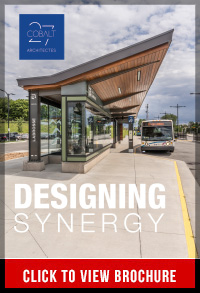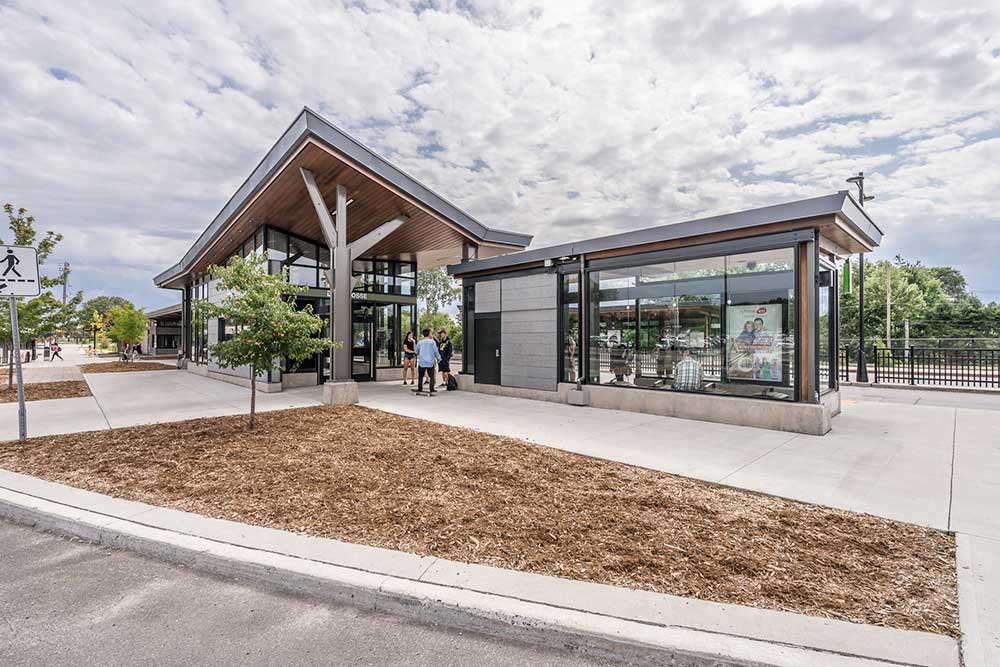Designing Synergy
By Anna Guy
If you’ve spent anytime in Montreal—even just a layover in the airport—you’ve felt the influence of Cobalt Architects (formally GCBD).
 The Quebec-based firm—comprised of a team of approximately 40 highly skilled architects lead by three partners—specializes in public transportation infrastructure projects, and, in its close to two decades—has helped form Montreal into one of the most the most well-planned cities in Canada. Recently undergoing a name change (the firm was previously known as Girard Côté Bérubé Dion architects, or GCBD), Cobalt still delivers outstanding design.
The Quebec-based firm—comprised of a team of approximately 40 highly skilled architects lead by three partners—specializes in public transportation infrastructure projects, and, in its close to two decades—has helped form Montreal into one of the most the most well-planned cities in Canada. Recently undergoing a name change (the firm was previously known as Girard Côté Bérubé Dion architects, or GCBD), Cobalt still delivers outstanding design.
Business Elite Canada spoke to Colbalt’s Eric Girard, Associate, about this company’s focus in public transportation, Institutional and Industrial architecture. “Architectural design inspires our team,” says Girard. “We have worked in public transportation since the very beginning; we started with a relatively small train station, and through projects ranging in size, we have developed a very strong reputation in this sector.”
“All the public transportation projects in Montréal, we are involved in.”
The Cobalt team is currently completing the plans and specifications for the Rapibus project as well as those for the VIA Rail stations. Serving the Ottawa-Gatineau region, the Société de Transport de l’Outaouais’ (STO) Rapibus is a fast bus system (SRB) transportation that uses exclusive bus lanes. It combines intelligent transportation system technology, and provides an integrated network of facilities, services and amenities that enhance reliability, flexibility and identity.
To achieve this, Cobalt has worked on over 12 kilometers of bus and cyclist routes, designing and installing nine key stops along the corridor. To ensure the comfort and safety of users in every respect, the Cobalt team implemented glazed surfaces into the design, as well as the “principle of “seen and be seen” which heightens passenger comfort—and security. To easily identify the specific Rapibus stations along the axis created and to highlight its presence in the areas served, Cobalt used a common architectural language largely inspired by natural features and landscapes specific to the Outaouais region, including the presence of hills, forests and rivers.
VIA Rail is one of Cobalt’s most long-standing clients, having worked with the agency since 2009 on project across the country, including stations Belleville, Coburg, Oshawa, and others along the Ontario-Quebec Route, to name a few. Sûreté du Québec in Vaudreuil-Soulanges and Sorel-Tracy, Societe de Transport Laval, Caisse de dépôt et placement (CDPQ), Metropolitan Transportation Agency, the City of Montreal, and Concordia University are among the clients who turn to Cobalt for their exemplary collaborative working culture, design acumen, and expertise. Cobalt is also currently working on CDPQ’s $6.4 billion electric train project—67 kilometres and 24 stations between Montréal, the airport, the North shore and the South Shore.
Cobalt has also acted as the airport planning consultant for the Montreal airport since 1995, providing professional analysis and planning services on all operational aspects of a terminal to facilitate efficient travel and regulatory obligations.
What is the secret to Cobalt’s successful projects? It’s a focus on the users, says Girard. “We work, of course, in tandem with a lot with engineers,” he says. “They are the ones who take care of the trains, the buses, the cars, and so one, but we take care of the people, the people who will use these buses and trains in their daily lives. When you can bring the community, the user, safely to their station, then their destination, everything is okay. We create a seamless transition between modes of transportation (subway to bus, for instance), which helps our city function.”
“The services we offer include all stages of a project, from design to construction,” continues Girard. “Our complementary services include development of development plans, feasibility studies and various expertise, as well as customer support in project management.” The end goal is synergy between the user and the environment.






